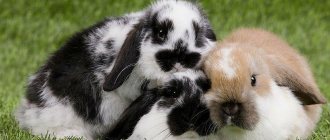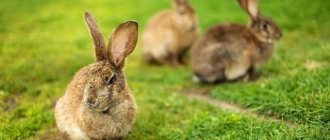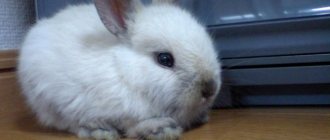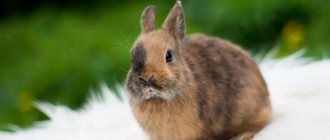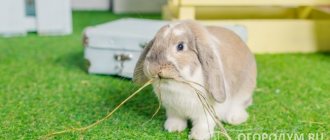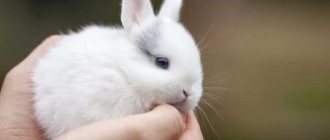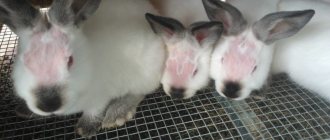The behavior of animals reflects their mood, well-being, and character traits, so you should carefully understand why the rabbit knocks its hind legs. This behavior carries an encrypted message, and understanding the body language of the wards will help you establish close contact with them. In addition, stress or illness of the animals may be among the reasons causing such actions. These manifestations require increased attention from the owners. This will create a comfortable environment for your pets.
How does a rabbit express aggression?
Experts believe that rabbits’ aggression towards their relatives is a completely normal phenomenon.
Juveniles often hit each other. With painless bites, herbivores can indicate to their family members that they must respect the hierarchy. How does a rabbit express aggression?
How can you tell if your pet is preparing to attack a person? Before the attack, he takes a characteristic pose - he presses his ears to his back and stretches his body forward. Herbivores that are kept alone in a cage often show aggression.
The less attention they show to the animal, the more aggressive it becomes. The long-eared cat can bite the owner on the forearm in case of resentment and anger
It is important to train your rabbit not to take out his bad mood on objects, as decorative pets can often start chewing shoes out of revenge.
Also, sick individuals can show aggression when trying to examine them.
It is important to train your rabbit not to take out his bad mood on objects, as decorative pets can often start chewing shoes out of revenge. Also, sick individuals can show aggression when trying to examine them.
A simple action has many meanings
A rabbit's simple action signal can express a spectrum of animal states. It's easier to understand with analogies. An example is a person winking, what could be simpler and more understandable? Meanwhile, a wink can be a signal:
- take action;
- terminate the action;
- hint, for example erotic.
Photo. A simple action can mean a lot. In humans this is called body language. Simple actions of a rabbit can also be complex in the semantic transmission of information.
An example of how simple can be complex. In the world of the rabbit, not everything is simple either. Rabbits clatter their hind legs, as if expressing aggression. In fact, there can be several meanings for the same “word”.
Movement and postures
To understand what the eared dog wants, it is important to take a closer look at its behavior:
The most common movement that demonstrates the joy of the long-eared animal is jumping and running. Often during games, animals run at high speed and flip over in a jump. Cheerfulness is also indicated by the pet jumping on chairs, sofas and tables. At the same time, they can shake their heads, inviting the owner to join in the fun. Eared cats often choose household items for games, so to avoid damage to them, it is best to purchase special balls. If the animal stands on its hind legs, then it explores the territory. A pet's mood is revealed by its ears. If they stand upright, the fluffy feels curiosity or tension
Herbivores also stand on their hind legs in order to better see objects located above. Sometimes with this behavior the pet asks to open the door for him, and if at the same time he pokes his nose at the owner, then he begs for attention and a treat. The position of lying on its side or back indicates relaxation of the animal. Most often, herbivores relax by stretching out their hind legs and resting their heads on their forelimbs
The behavior indicates a feeling of security and calm. If a pet rolls over onto its back, then this is a sign that it completely trusts its owner. You should not turn your long-eared dog over on your own, as this is a lot of stress for him, leading to tonic immobility. Rabbits love to rummage through things and towels. It is the natural instinct of herbivores to dig holes. To protect clothes from damage, it is recommended to place a box with earth or sand for your pet. Females like to move objects around, arranging them as they see fit, so it is best to hide all valuables. The rabbit sits tensely, which means it is dissatisfied. In this way, the pet can show that it does not like the human touch. The big-eared one can bend down to the floor even after rabbit fights, showing submission and the end of the fight. Freezing in place is a sign of fear. Feeling fear, the herbivore points its ears up or forward, its breathing quickens, and its eyes open wide. Thanks to this behavior, the animal tries to remain unnoticed and avoid danger. Why do rabbits clatter their hind legs? This is how they express their dissatisfaction. Rearranging the apartment can cause this behavior, since long-eared animals love stability, and even a small change in the environment can frighten the pet. By knocking its paws, an animal in the wild gives a danger signal. Decorative rabbits can behave this way at night out of boredom, fear or loneliness. Female rabbits may stomp during mating, as this process is stressful for them.
When an animal is stampeding, it is important not to chase it. Cardboard boxes or pieces of furniture can become a shelter for a herbivore. Under no circumstances should you invade the territory of a rabbit’s shelter and take it out of there.
To calm and lure your pet, just squat down near the house and offer him a treat. If the eared one does not make contact, then it is better to leave it alone for a while. When your pet feels curious, he may twitch his nose quickly and jerkily, sniffing everything around him. If a herbivore is alerted by some smell, it begins to stretch its head and quickly inhale air. However, sometimes frequent, jerky breathing indicates the development of disease. This symptom is typical for pneumonia, heart failure and overheating in the summer. Before eating, the rabbit may first sniff the food and nibble on it. Animals usually do this when new foods are added to their diet. By testing the teeth, they test the food for toxicity.
Under no circumstances should you invade the territory of a rabbit’s shelter and remove it from there. To calm and lure your pet, just squat down near the house and offer him a treat. If the eared one does not make contact, then it is better to leave it alone for a while. When your pet feels curious, he may twitch his nose quickly and jerkily, sniffing everything around him. If a herbivore is alerted by some smell, it begins to stretch its head and quickly inhale air. However, sometimes frequent, jerky breathing indicates the development of disease. This symptom is typical for pneumonia, heart failure and overheating in the summer. Before eating, the rabbit may first sniff the food and nibble on it. Animals usually do this when new foods are added to their diet. By testing the food on the tooth, they test the food for toxicity.
Infectious diseases that cause paw damage
Listeriosis in rabbits
One of the reasons why a rabbit's hind legs failed is listeriosis. This is an infectious disease of bacterial origin that affects the mammary glands, nervous and genitourinary systems. Most often, young animals and pregnant female rabbits are affected. Goats, sheep, pigs, cattle, poultry and people can get sick.
Sources of infection
- Sick or recovered rabbits (long-term carriage, up to 2.5 months).
- Rodents (rats and mice).
- Wild animals (foxes, hares and others).
- Insects (lice, fleas, ticks, gadfly larvae).
- Man (as a mechanical carrier).
Infection can occur through contact with sick animals, through nutrition (contaminated feed and bedding), through damaged skin and mucous membranes.
Manifestation of the disease
The disease can occur in hyperacute, acute, subacute, chronic (latent) and atypical forms. Manifested by the death of pregnant rabbits (immediately after or before childbirth), abortion during pregnancy, mummification (drying out) and decomposition of fetuses, mastitis, metritis and endometritis (inflammation of the uterus), death of the entire litter after childbirth, brown vaginal discharge, paresis or paralysis of the hind legs. limbs in rabbits. Rabbits lose weight, eat poorly or refuse food altogether, and their fur becomes disheveled and dull.
With an atypical form of the course, the clinical picture may be similar to a false pregnancy. In such a situation, the rabbits die while they are still embryos, and the female rabbit cannot become pregnant and give birth. Other signs of the disease may be absent, although the animal remains a carrier of the pathogen.
Carrying out therapeutic measures in rabbit farms is economically unjustified. Even if recovered, animals remain carriers and will be infertile, and there is also a risk of infection in humans. Sick rabbits are killed, the rest are vaccinated. Meat can be eaten, but only after long-term boiling (at least two hours). The skins are disinfected.
For the treatment of decorative rabbits, antibiotics ("biomycin", "tetracycline" and others), immunostimulants ("roncoleukin"), stimulants of metabolic processes ("catozal", "gamavit", "mikrovitam"), homeopathic drugs ("traumeel", " Engistol", "Echinacea compositum").
If there are signs of damage to the nervous system, the therapy described above (treatment of listeriosis) is used.
Prevention
For prevention it is necessary:
- Examination and quarantine of incoming animals.
- Control of insects and rodents (disinsection and deratization).
- Control and purchase of feed only from reliable and prosperous farms.
- If there is a threat of infection, vaccination is carried out (with a vaccine from the AUF strain).
Encephalozoonosis of rabbits
The disease is caused by intracellular parasites of the protozoan class, manifested by damage to the nervous system, as well as the kidneys and other internal organs (liver, spleen, heart, eyes, intestines). Infection occurs through the nutritional route, the pathogen is excreted in urine, feces, and a transplacental (intrauterine) method of infection is also possible.
Symptoms
Pathology can manifest itself:
- Loss of coordination and torticollis.
- The pupillary reflex may be absent.
- Movement of the animal in a circle.
- Paresis, paralysis and atrophy of the muscles of the limbs.
- Development of uveitis (inflammation of the eye vessels) and lens opacity.
A feature of the pathology is that in most animals the disease occurs as a carrier and begins to manifest itself only when exposed to factors that weaken the immune system. An accurate diagnosis is made only based on the results of laboratory diagnostics.
Prevention
- Timely disinfection.
- Prevention of weakening and support of immunity in animals (high-quality feeding, absence of stress, drafts, hypothermia).
How to solve a problem
If the female rabbit does not want to let the male in, the problem is eliminated based on the reasons for the refusal.
If a female rabbit is mating for the first time, it is recommended to take an experienced and proven male for her. Old females, on the contrary, are better off with young rabbits.
For full gestation of fruits and for pronounced hunting, female rabbits need vitamins. Trivit, which contains vitamin E, is suitable.
For an excessively fat female, the diet is reduced so that she acquires breeding condition. For exhausted animals, on the contrary, the amount of food is increased. Sick rabbits should be culled.
If the animal does not like the small room, move it to a larger enclosure. Experienced farmers advise placing the cage in the sun - the female will spontaneously develop a state of hunting.
It should be remembered that, regardless of the state of the body, female rabbits do not mate well:
- in autumn;
- in the summer heat;
- during the molting period.
It is also necessary to monitor the pregnancy of the animal - if the female is already fertilized, then she behaves aggressively. Females may bite the rabbits or make "moaning" noises that they don't mean to happen.
To stimulate rabbits to hunt, add celery to them and increase the lighting. The temperature should not be higher than 25 degrees and lower than minus 5.
There is a folk way to help a female rabbit - they put her in the cage where the male was previously sitting, so that she gets used to his smell. You can also place the female with an active male for 15 minutes. This is done several times, after which the rabbit herself will come into a state of hunting. In any case, for covering, you need to place the female in the rabbit's cage, and not vice versa.
Try not to make mistakes in rabbit breeding. Often, for beginners, the female rabbit is already fertilized because the farmer incorrectly determined the sex of the animals during seating and the male was sitting with the female.
Reasons for eating baby rabbits
It can be difficult to identify the reason for such actions of the mother rabbit. This happens very rarely, but almost every rabbit breeder has encountered this. Usually the rabbit does not eat the baby completely, but only gnaws off some parts of the body. A place eaten by a mother requires a lot of attention. It can be:
- Stomach. A young mother, due to her ineptitude, may bite the baby rabbit on the stomach, wanting to gnaw the umbilical cord.
- Head. This happens mainly when the rabbit tries to clean the baby from the shell.
- Ears or paws. This happens when the rabbit wanted to pull the baby out with her teeth, but it didn’t work.
Rabbits' teeth are sharp and very strong.
It happens that female rabbits perform abortions by eating newborns. At the same time, the rabbit does not understand what happened to her and mistakes the rabbits for garbage, wanting to remove the cage. Also, the mother can accidentally trample the baby, after which she eats it, so as not to attract predators to her home and to protect herself and the rest of the cubs.
Sometimes such a misfortune can happen due to lack of water in the mother's body. During childbirth, the female loses a large amount of fluid and begins to experience an enormous feeling of thirst. As a result, she eats the cubs, wanting to replenish the water balance in the body.
Also, eaten offspring can be the result of stressful situations in the rabbit, because of which she decided to clean out her home. And, of course, the most common reason why female rabbits eat their offspring is sick rabbits. If the rabbit felt that the cubs were born unhealthy or with abnormalities, she will rush to get rid of them.
The female never touches healthy rabbits
Behavioral reactions of rabbits
Eared animals express their sensations, emotions, and states through certain behavior. Moreover, the same movements of individuals can have different reasons.
For example, an animal tapping its paws on the floor in different situations can mean fear, excitement, irritation, dissatisfaction.
In some cases, the rabbit thus strives to attract the owner’s attention and warn its relatives about imminent danger.
Some behavioral manifestations indicate unfavorable housing and feeding conditions. It is still impossible to unambiguously interpret the different behavior of these animals, since it often changes in accordance with the different conditions of their habitat.
Various bodily signals and behavior of eared animals are a means of their self-expression. Only by understanding animals can we find the most appropriate approach to them.
This is interesting: Keeping rabbits outside in winter - we present them in order
Could this indicate danger?
The clattering of hind legs can be a signal of impending danger. For wild rabbits, in most cases, knocking with a paw means “Alarm!”, “Attention!”, “Danger!” So, in their natural habitat in their colonies, rabbits warn each other about predators, fires, hunters, and floods. Therefore, paw tapping is not a meaningless movement of an animal, but a signal that conveys important information.
Rabbits have their own “language” of communication, like all mammals that live in groups. In humans, a similar, nonverbal form of communication (without words) is called body language.
Photo. The rabbit knocks its paws, which means it is angry. Animal language is much richer than we think.
Additional Information
The rabbit transmits information intended for other animals (enemies or friends) to humans in different ways:
- characteristic poses;
- specific movements;
- olfactory marks;
- touches.
In the wild, the powerful thump of a rabbit's hind leg is a danger signal to all members of the pack. This is the most common non-verbal signal of rabbits living in stable groups - colonies. Both females and males knock with their paws; the signal has no sexual specialization.
Knocking with a hind paw is a danger signal for all members of a rabbit colony.
In short, that's it. A rabbit taps its paw when it is scared and wants to tell others about it. Everything that follows is additional and optional information.
Read more: all about wild rabbits
If Peter Rabbit winked at you, it means you understood his soul, this is what Biatrix Potter meant
Therefore, in order, about all the meanings of the “language” of rabbits.
Rabbits are considered emotional animals. The pet informs the owner about its condition in different ways: stomping its hind legs, spinning, jumping, scratching the cage, running. The non-standard behavior of a pet is explained in different ways:
He presses his ears to his head, lies down on the ground and freezes - the pet is frightened by something dangerous: your presence, loud sounds, moving the cage from place to place. Ears flat against the head also signify obedience. Stands on its hind legs, raises its ears, sniffs and listens - the rabbit is interested in what is happening around. If the pet looks at you and folds its paws, then it is begging for a treat. He weakly bites a person's fingers - he plays. If the bites are aggressive or cause blood, it means that he is dissatisfied with something: the quality of food, the cleanliness of the cage, loneliness. It is worth thinking about why the animal behaves this way. Lies on its back, spreads its paws in different directions - the animal is resting. If he allows you to scratch his belly, it means he completely trusts you as his owner. The rabbit stomps, runs, actively jumps, throws objects - plays, he is in a good mood. This is how the genes of wild ancestors appear in him, who use similar actions to escape persecution. Hugs into the corner of the cage, spends most of the day there - the pet is very scared
Perhaps loud noises, increased attention from small children, or another animal showing aggression are to blame.
To attract attention
Sometimes in such a universal way they show their playful attitude and also attract attention. In this case, you will notice that the rabbit looks very lively, active and energetic.
He may start pounding with one hind paw or two at once - as if right now he will rush off into the distance, his heels sparkling. But in reality, the pet wants to be paid attention to. It's like he's saying, “Hey, look at me! Do you see how fast I can run? How nimble and mischievous am I?” In this case, be sure to satisfy the rabbit's needs, pay attention to him, reward him with a treat and play.
Important! Rabbits are not particularly verbal creatures. And knocking with their hind legs is one of the surest ways for them to communicate something. They will never do this without a special reason. Therefore, be sure to pay attention to this signal and try to determine what your pet wants to tell you.
What to do if rabbits fight each other
Rabbits fight among themselves for the following reasons:
war for territory; struggle for dominance.
You can solve the problem in the following ways:
- sterilize or castrate (does not always help);
- seated in different cells;
- introduce the new animal to the others outside the cage and in no man's land;
- pet and feed the animals when they are together;
- do not interfere with the distribution of roles;
- pull apart only if the animal squeaks, there is blood, or two people are rolling around in a lump.
Thus, if your rabbit growls and bites, do not rush to get rid of it, this behavior has very simple reasons and indicates that your pet is very smart. This means that he will be able to learn the basics of education.
To solve the problem of aggression, it will take time and your love, but in return you will receive an affectionate fluffy ball that loves to bask next to you.
Determination of hunting in female rabbits
The female can be covered the very next day after the birth process. Most breeders are of the opinion that lactation together with pregnancy puts too much stress on the animal’s body, and therefore coating is recommended after finishing feeding the young animals.
Rabbits are known for their willingness to reproduce continuously, but in real life this does not always happen. In any farm, a situation may arise when the female refuses to allow the sire to approach her; the reasons for this behavior have already been written about.
Another factor influencing the behavior of the female rabbit is very weak hunting or its complete absence. In this state, the female begins to rush around the cage, tries to find a secluded place where the male cannot find her, and as a last resort aggressive behavior is demonstrated.
If the female rabbit is ready to mate, then she begins to set up a nest, rub against the walls of the cage, and test the food containers. Also, females can show aggression towards individuals of their own sex, sometimes refusing to feed.
You can detect heat in a fairly simple way: grab the animal by the scruff of the neck. If the female begins to squat and raise her tail, then the breeder can be allowed in. At this time, swelling of the genital loop occurs, the color of the mucous membranes can be from bright pink to red.
Sign language
Running fast: Runs around the house at top speed, alone or chasing you or another rabbit, just for fun.
Jumping: An upward jump with a half-spin in the air and a twist, usually performed mid-run. The rabbit is happy.
Hitting with its hind legs: The rabbit stands and hits the floor hard with its hind legs. This is a sign of dissatisfaction.
Moving objects: pushing, pulling, biting bedding, towels or pillows. The rabbit rearranges everything at his own discretion.
Sits with its legs tucked under itself: the rabbit's front and back legs are hidden under its body. The bunny looks like she could fit in a loaf pan. Rabbits often sleep in this position. This means that the rabbit is a little cold or just comfortable.
The rug lies with its paws stretched out to the sides: The rabbit lies on its stomach on the floor, the hind legs are extended behind, and the front legs are extended in front. The rabbit can also lie on either side. Means calm, comfort and relaxation. Rabbits often sleep like this.
Digging: a burrowing, instinctive behavior.
Chewing: natural behavior.
Chin Marking: By rubbing objects with its chin, the rabbit marks its territory. On the chin there are odorous glands with an elusive odor to humans.
Circling: Circling around the legs of a person or another rabbit may be part of a mating dance or a means of attracting attention. Humming (vocalization) may also accompany circling.
Rock climbing: learning and play behavior.
Digging: natural behavior. This can also be a sign when the rabbit is excited about something, but does not intend to attack.
Changing the position of the ears: This is the rabbit's sonar to determine what is happening around it.
Both ears forward: Something attracts the rabbit's full attention.
One ear forward, one ear back: the rabbit is interested in two different sounds at the same time
Both ears are tilted back and pressed to the head: fear, a sign of submission or a desire to attack (the tail is straightened and the body is tense).
Eyes: Third eyelid at the corner of the eye. If it is strongly visible, then most likely it is a manifestation of fear.
Sudden fall on its side: The rabbit literally flops onto its side. The rabbit decided to rest and feels relaxed.
Invitation/Demand to Pet: The rabbit approaches you, nudges you and lowers its head to the floor in an extended position with its ears on the sides of its head and awaits your attention. Your rabbit wants attention and grooming from you.
Licking: an expression of love that has nothing to do with the need for salt.
Lunge: a sign of disapproval.
Attempting to mate: mating or dominant behavior.
Pinching: Feels like a slight tingling sensation and can mean several things (this is not the rabbit's intention to bite). The rabbit wants attention, a sign of courtship, an attempt to politely ask to get out of his way, a warning that your actions are undesirable for him.
Nose nudge: Rabbit nudges with its nose.
Trying to attract attention, asking him to pet him or asking him not to stand in the way
Stands on its hind legs: The rabbit stands on its hind legs and looks around.
Tail position: When straightened, it is a sign of interest or aggression. Wagging is a form of defiance or talking.
Throwing around the cage: play behavior or display of anger.
Stretched his paws forward, mouth open, growling: an expression of anger or a warning about violation of his territory.
Irritation
The reasons for dissatisfaction or irritation may vary. Owners note that most often pets knock their paws in the following situations:
- replacing the old cage with a new one;
- Even a small rearrangement in the room irritates the animal. After all, he needs to re-adapt to the situation;
- It can be irritating for your pet to be forcibly removed from the cage to clean the inside of the structure. The best solution is to clean the cage when your pet goes for a walk.
Brain inflammation
In order for the different systems of an animal’s body to function, the correct uninterrupted functioning of its brain is necessary. In this case, a living being reacts to a variety of external and internal factors, thinks, has different reflexes, etc. Also, if everything is in order with the brain, the rabbit moves quickly and clearly. If this organ is damaged, the consequences can be dire, and important functions are lost. If the rabbit breeder, together with veterinary specialists, fails to do anything, the animal dies.
If the pet's hind legs fail, this means there may be problems with the rabbit's brain; it may be inflamed. But such symptoms apply to several diseases.
With encephalitis, a sick rabbit does not stand up on its limbs, its head turns to the side. It is very difficult to cure an affected individual; even if in rare cases it works, a number of important impaired reflexes cannot be restored.
With encephalomyelitis, the brain is affected after an infectious disease. The animal's paws can be paralyzed. If you miss the moment when the first signs of the inflammatory process appear and do nothing, the rabbit can die within a day or four days.
With meningitis, both the brain and spinal cord become inflamed. The last resort is to kill the rabbit. But first you need to consult a veterinarian. Similar symptoms are observed with damage to the central nervous system, and it can be restored; specialized medications will be required; if you contact a specialized veterinary clinic at an early stage, the rabbit’s recovery is possible in a week.
As preventive measures to prevent paralysis of rabbit legs, you need to protect animals from falls, stress, communication with aggressive other pets at home or in the yard, consult a veterinarian once or twice a year, and give rabbits vitamin-mineral supplements or medications, for example, aminazine, monitor your diet and cell cleanliness.
Causes of hind limb paralysis
In order to know how to act in a situation with a sick animal, it is advisable for the farmer to know what causes the problem. They can be divided into two large groups: external and internal. The former are associated with negative environmental factors and physical impact, the latter with infectious and other diseases.
Table 1. Why a rabbit’s hind legs may fail
| External reasons | Internal reasons |
| 1. Mechanical injury: fracture, dislocation, damage to nerves and ligaments. 2. Stressful situation: the animal was severely frightened or transported to a new place of residence with completely different conditions. 3. Incorrect care: bad food, cells that are too small, etc. 4. Frostbite or burn of the hind limbs. 5. Side effect from mechanical injury to the spine. 6. Falling from a great height and hitting sharp objects. | 1. Vitamin deficiency and lack of minerals (especially calcium) in the body. 2. Presence of infectious diseases. 3. The consequences of mass epidemics spreading in a certain area. 4. Pinched motor nerves. 5. Spinal hernia. 6. Weakened immunity. |
Failure of a rabbit's hind legs can happen for various reasons.
Practical use of any rabbit signals
- sexual arousal (the female rabbit's immobile posture is the beginning of estrus, lifting her tail, raising her butt is a sign of readiness for mating);
- aggression (transmitted by sounds, throws, posture of readiness to throw)
- fear (posture of submission, sounds of submission).
The above is the most important information used when carrying out matings of male and female rabbits, uniting groups of rabbits for joint keeping (pit rabbit keeping), keeping a female rabbit with rabbits.
- animal (first) signaling system;
- human (second) signaling system.
Rabbits often make sounds, so the breeder needs to learn to recognize their meaning correctly.
- grinding teeth - pleasure, relaxation, good mood;
- loud chattering of teeth - pain;
- grunting - irritation, dissatisfaction, and with frequent and loud manifestations indicates the development of diseases;
- hissing and growling - anger and aggression;
- scream - severe pain, fear;
- Quiet squeaking of baby rabbits - cold or hunger.
We invite you to read why honey quickly thickens and turns white
Note! When rabbits purr, what does it mean? An animal may purr like a cat when it expresses its gratitude for a treat. Also, this behavior indicates that the pet loves its owner very much and feels affection, devotion and trust towards him.
Why do rabbits lick hands? Herbivores are social animals, staying in contact with others half the time. The rabbit licks its lips while performing hygiene procedures. When he begins to lick his relatives, in this way he strengthens family ties. If a pet begins to behave this way towards a person, this indicates that he has accepted him into his family.
Note! If an animal begins to lick all surrounding objects, this indicates its loneliness and a feeling of stress. When males jump on each other, they can play like this or show their dominance in the family
If a male behaves this way towards a female, this means sexual attraction
When males jump on each other, they can play like this or show their dominance in the family. If a male behaves this way towards a female, this means sexual attraction.
Understanding rabbit behavior is not difficult. The animal itself transmits the feelings it experiences. Aggression is not always a sign of anger; it may indicate loneliness of the pet. Long-eared animals usually do not hide their love for their owner. It manifests itself in the desire to lick a person and his things, rub himself on his legs and purr
It is important to learn to recognize warning signs indicating illness, since a timely response can save your pet’s life
What does the sound of your hind legs hitting the floor mean?
If a person is just starting to engage in rabbit farming, then he inevitably encounters various behavioral phenomena of animals. It is necessary to understand the possible sources of deviant behavior that at first seems difficult to explain. This can be influenced by internal and external factors.
There are several important reasons that explain why rabbits knock with their hind legs:
- dissatisfaction of animals caused by sudden changes in the usual conditions of keeping and feeding;
- stress, fear, when the animal hits the floor out of confusion or fear;
- warning of external danger using loud sounds caused by rabbit paws;
- sexual arousal, readiness to mate;
- the need to communicate with a person.
It is possible to understand why long-eared animals produce a kind of “drum roll” only by taking into account the entire set of conditions. In different situations, the cause of such behavior is fear, aggressiveness, excitement, and anxiety. A caring attitude towards the wards will allow you to notice changes in their condition in time and quickly take measures to improve the external conditions of detention.
How does the treatment work?
Paralysis of the hind limbs always entails side effects, so treatment includes various measures. The animal is given painkillers and anti-inflammatory drugs to relieve discomfort and prevent inflammation of the nerves and tissues at the site of the lesion. All medications are prescribed by a doctor, and the task of the animal owner is to remember all the recommendations and follow them exactly.
For rehabilitation, the rabbit needs to have a massage
It is necessary to massage the hind legs to quickly restore their mobility. This method avoids tissue death and improves blood flow. Artificial gymnastics will help the animal fully restore motor functions and coordination.
It is very simple to carry out: you need to slowly and carefully bend and unbend your paws for several minutes. If an individual with paralyzed hind legs generally feels well, then it can and should be taken for a walk in the fresh air and allowed to crawl on the grass under supervision
Prevention measures
Preventative measures can reduce the risk of paralysis by 50%. To protect your pet from such a fate, adhere to the following rules:
- Have your rabbit checked regularly by a veterinarian.
- Monitor the animal's diet. He should get plenty of fiber, as well as other vitamins and minerals in sufficient quantities.
- Keep your pet clean. Clean your rabbit's cage, tray, and feeder regularly.
- Do not leave your animal unattended for a long time, especially during walks, to avoid injury.
- You should provide him with the most peaceful life possible. Do not provoke fear and stress in him.
- If there are children in the family, make sure that their games with the rabbit are not harmful to the animal.
Sounds
Long-eared pets use not only body language - they also make a variety of sounds. For example, when a sexually mature animal is ready to mate, it may emit guttural screams, as cats often do. And baby rabbits call their mothers with a quiet squeak - adults can only make it when they are very scared or cannot figure out what is happening.
An angry rabbit will hiss and growl - be careful! An animal may bite you; it is better to wait until the pet calms down and then make contact with it.
But most often, new owners are interested in why rabbits grind/chatter their teeth. If the animal does this not during feeding or illness, such sounds indicate the highest degree of calm and pleasure. Happy rabbits express their love for their owner in this way.
General observations.
The more you communicate with rabbits, the more convinced you are that each of them is an individual. Everyone has their own character, inclinations, habits. Therefore, take these observations into account whenever possible. When a rabbit is comfortable, stress is minimized, he gets sick less, develops faster, and gains the required condition. I probably missed some points from the proposed topic. Perhaps your rabbits can express their emotions and feelings with other sounds and gestures. In this case, please share your observations and supplement the article. I will be very grateful to you!
Please share this article with your friends on social networks:
Please rate the article. Ask a question, discuss on the forum.
Communication with humans and other rabbits
Rabbits often react to situations or stimuli by tapping their hind legs, jumping, or making unusual sounds.
It is important to correctly “read” your pet’s behavior in order to help him quickly get used to a new room or teach him how to communicate with other animals. You can eliminate aggression or irritation in different ways:
- place the pet in a quiet and calm place indoors;
- the construction of a spacious enclosure will allow the big-eared cat to walk freely at any time of the day;
- The best way to communicate is to lean towards the animal, rather than lifting it high to hold it in your arms.
If there are other rabbits in the apartment, it is important to ensure that the newcomer is not offended when meeting him. Also, sometimes the female knocks with her paws when she is placed in the male’s cage for mating
To correct the situation, it is recommended to postpone the mating procedure for several days (or another partner is selected for the female rabbit).
Decorative rabbits do not often show aggression or irritation. To prevent such behavior, you need to know the reasons that provoke such reactions.
It is also important to be able to correctly eliminate manifestations of fear, aggression, fright
Marks territory
Rubbing his chin —marking things. On the rabbit's chin there are submandibular glands that secrete a certain smell, so they rub against objects to tell everyone: “I marked this and it is now mine!”
Streams of urine while jumping , puddles in the wrong places - basically this is a sign of hunting: rabbits use marks to mark the territory and attract partners.
Scatters peas - droppings not collected in a heap, but scattered around the room - a sign that this territory belongs to the rabbit. This often happens when the rabbit’s habitat changes (moving, new enclosure, another room). If a fellow rabbit lives in the same room as a rabbit, such marks may appear more often.
Putting wool and hay into the mouth - a false pregnancy or pregnancy in a female. At this point, the female may become nervous, irritable and somewhat lost: she builds a nest from her wool, hoes, hay and her instincts tell her that she will soon have children! Sometimes, during a false pregnancy, rabbits stop eating. If there are frequent false pregnancies, the rabbit is castrated.
Communication with humans and other rabbits
Experts do not recommend picking up your pet without special reasons. Herbivores react poorly to a sudden loss of stability and the inability to control their body. The animal may become very frightened, freeze in fear, or begin to struggle. Sometimes attempts at release can end in injury to the pet. If the long-eared animal jumps into the owner’s arms, this indicates complete trust in the person, but even in this case the pet cannot be kept.
The rabbit taps its hind legs
Why do rabbits lick hands? Herbivores are social animals, staying in contact with others half the time. The rabbit licks its lips while performing hygiene procedures. When he begins to lick his relatives, in this way he strengthens family ties. If a pet begins to behave this way towards a person, this indicates that he has accepted him into his family. Most often it licks the owner's palm, in some cases the animal licks his things. Previously, it was generally accepted that the licking rabbit lacks nutrients, so it tries to compensate for them in this way. However, experts are sure that licking is a way of communication for long-eared animals.
Note! If an animal begins to lick all surrounding objects, this indicates its loneliness and a feeling of stress. When males jump on each other, they can play like this or show their dominance in the family
If a male behaves this way towards a female, this means sexual attraction
When males jump on each other, they can play like this or show their dominance in the family. If a male behaves this way towards a female, this means sexual attraction.
Understanding rabbit behavior is not difficult. The animal itself transmits the feelings it experiences. Aggression is not always a sign of anger; it may indicate loneliness of the pet. Long-eared animals usually do not hide their love for their owner. It manifests itself in the desire to lick a person and his things, rub himself on his legs and purr
It is important to learn to recognize warning signs indicating illness, since a timely response can save your pet’s life
The behavior of animals reflects their mood, well-being, and character traits, so you should carefully understand why the rabbit knocks its hind legs. This behavior carries an encrypted message, and understanding the body language of the wards will help you establish close contact with them. In addition, stress or illness of the animals may be among the reasons causing such actions. These manifestations require increased attention from the owners. This will create a comfortable environment for your pets.
Why don't hares knock their paws on the ground?
The order Lagomorpha (Lagomorpha) includes three families: hares, rabbits, and pikas. Rabbits and pikas live in stable groups, in burrows, while hares are solitary. Evolutionarily, rabbits have developed a system of warning signals that help them collectively escape from enemies when threatened. One of the rabbits signals the entire group of relatives, who immediately hide in holes. The second adaptation of rabbits is cecotorphy, eating feces. Feces (cekotorof) are rich in essential substances. Having received a danger signal, the rabbits sit out in the hole, while being saturated with useful substances, enjoying their own feces. This is very convenient in conditions of limited time spent on the pasture, on the surface of the earth.
Hares are solitary, they have no one to signal danger to, they just need to run away
Run, hare, run. Although some sources mention such strange signaling in hares. Or maybe this is a wrong translation? The thumping of pikas with their hind legs is not described in the literature, although they signal danger with a high-frequency sound, they are sometimes called “whistling hares.” Hares also do not knock on the ground or stumps with either their front or hind paws.
Useful tips
Experienced rabbit breeders claim that even the most furious rabbit can be pacified, because 99% of these animals have a friendly disposition. To establish friendly relations with your pet and prevent its atypical behavior, first of all, take care of a spacious rabbitry and pay enough attention to its resident. And then, slowly, patiently walk towards your goal.
The following tips will help you with this:
Never remove an animal from its cage against its will. Do not, under any circumstances, resort to violence or hold someone in your arms. This will only aggravate the situation and intimidate the eared one even more.
When transplanting an animal into a new cage, do not interfere with its adaptation. Give him time to look around and get used to the new conditions. You can touch your pet when it begins to preen itself, wash itself, try the pre-supplied food, and carelessly stretches out on the floor.
Do not lean over a closed enclosure. Such actions will make the rabbit afraid, destroying his confidence in his own safety. To avoid associating the poor fellow with an attacking predator, squat near the cage door.
Talk to your rabbit often in a low, calm voice. But at the same time, you cannot stand at the cage at full height. Protect your ward from noise and screams.
Each time you put your hand into the cage, do not make sudden movements. Give the long-eared one a chance to sniff you, treat him with something tasty. In the future, this will allow the animal to get used to your smell, and it will stop seeing you as an enemy.
If your pet curls up into a ball when you try to pet it, it is better not to injure it.
Every time your rabbit calmly approaches you, reward him with affection or a treat. This will serve as reinforcement for the desired behavior.
If, despite good maintenance and treatment in the presence of a partner and good health, the animal continues to behave atypically, you need to let it know that you do not claim a place in the rabbit hierarchy
It is important here that the rabbit does not feel superior to the owner, so during the next attacks, calmly and confidently move the aggressor to the side, do not succumb to his provocations, ignoring the attacks.
During the initial stages of establishing contact with your cat, keep your hands as far away from his face as possible at all times. When your pet notices your hand from afar, he will begin to get used to it and calm down.
If after that he does not attack, you can gently try to pet him. Over time, the distance needs to be gradually reduced, and then even bring your hands close to the pet.
Read also: Types of decorative pumpkins photo
Aggression in rabbits cannot be caused by hostility towards the owner. As you can see, it is accompanied by certain reasons
It is important to immediately recognize and eliminate them, without causing discomfort to the silent ward, because such atypical behavior also causes discomfort to him. We hope our article will help you get along with your big-eared
Why does a decorative rabbit bite, aggression in rabbits. People are often shocked when they encounter aggression in rabbits. They cannot imagine that such timid and sweet rabbits can bite and scratch painfully. But aggression in rabbits is quite common. Research has shown that aggressive rabbits are more intelligent than timid ones. Once you begin to respect your rabbit and adhere to certain rules when interacting with him, rabbits will become attached to you very quickly.
Decorative breeds
There are more than 200 breeds of decorative rabbits. They live 5-7 years, but with careful care their life is extended to 10 years.
How to care for rabbits depends on the characteristics of the breed. The following animals are most often bred:
- Colored dwarfs, or dwarf shorthairs. They got their name because of the variety of colors (more than 60 species), but white is considered the most beautiful. Until they are one and a half years old, they scratch and bite. To reduce aggression, castration is performed.
- Lion breeds (Lions). They are called so because a mane grows around the neck and head, like a lion. And even with their muzzle, some look like the king of beasts. This type is called Lion's Head. These are small animals, weighing no more than 1.2 kg. There are rabbits with long hair - the Angora lion. The fur hangs over the eyes and covers the ears. It needs to be trimmed regularly. Lions have such a calm character that it is safe for children to play with them.
- Dutch rabbits. They have an interesting color, shiny, soft wool. They weigh no more than 1 kg, but there is a separate species that grows up to 2-2.5 kg. The animals are obedient, smart and sociable, get along well with children, but are energetic and require increased attention. Easy to care for.
- Angora rabbits are fluffballs of two types. One has fur with a hair length of up to 20 cm, which feels like cotton wool to the touch. Your fur coat requires daily care. Another species has shiny fur that does not exceed 5 cm in length, which makes it easier to care for.
- Dwarf rexes. They grow up to 1.4 kg in weight. They have royal status. They are called plush for the quality of their wool. A fur coat of amazing beauty and a wide range of colors requires careful care. Smart, obedient, safe for children, easy to train. This makes caring for rabbits easy and enjoyable.
- Fold sheep are cute, harmless animals with a good character. They have a head similar to a lamb, long hanging ears (22-27 cm), due to which they have difficulty hearing. Thanks to this, they are extremely calm and fearless, which is why keeping decorative rabbits of this breed is recommended for families with small children. Caring for them is easy.
The smallest breed is Hermelin. Its representatives weigh less than 1 kg. Animals are capricious in their care: they are sensitive to temperature conditions, have a complex, independent character, which complicates communication.
Rabbits have a lot in common with cats in character and habits.
How to keep a rabbit? This is the daily work and attention that a furry pet requires. Sometimes maintaining them involves unpleasant troubles
Keeping decorative rabbits at home can be done by someone who is not afraid of worries, is ready to forgive pets for their pranks and put up with certain inconveniences. To care for and maintain decorative rabbits you need the following equipment:
- A large, comfortable cage with a solid floor, because the structure of the legs does not allow free movement on the grid. Cover the corner of the cage or place a box for the pet to hide there.
- Aviary, if walks around the apartment are not provided.
- A drinking bowl or feeder is preferably heavy, for example ceramic, so that the eater who likes to scatter food does not turn it over with his teeth. A plastic feeder is attached to the cage. Container for storing hay.
- A tray with litter, a scoop and vinegar to neutralize urine odor.
- A thick branch for a rabbit to sharpen its teeth.
- Scissors - cut nails, combs and grooming brushes.
- Toys to chew on instead of furniture.
Caring for rabbits at home does not require special knowledge, although the animals are gentle, have weak immunity and are susceptible to diseases.
Caring for rabbits at home does not require special knowledge
When does a rabbit stop being silent and start screaming?
However, in rare cases, rabbits can still give their voice. In moments of extreme danger or severe pain, they emit a piercing scream or rather a squeal. They try to endure ordinary pain in silence. For wild rabbits, this innate quality often saves their lives, since enduring pain means preventing themselves from being detected by a predator. In households, on the contrary, it can play a cruel joke. Often a sick pet does not reveal itself in any way and thereby misleads inexperienced farmers. Only at the last moment does the rabbit suddenly begin to squeal loudly and immediately die in front of the owner’s eyes. But timely treatment could certainly correct the situation.
The loud screams of rabbits can also be heard during their martial arts. If, for example, a wild brother defends his right to a certain territory or two adult males were inadvertently placed in one cage, as well as during a planned replacement of a male during pit (aviary) keeping. At first, the animals seem to measure their strength, then the strongest begins to pursue the weaker. Sharp teeth turn out to be formidable weapons, the bites of which cause severe pain. Yes, and hitting with paws can lead to irreparable losses.
Possible preventive measures
Pathology can be successfully avoided if due attention is paid to the conditions of keeping rabbits. Firstly, you need to take care of proper nutrition: animals should receive a full range of vitamins and microelements; lactating rabbits and young animals should be given calcium supplements
Secondly, cages and premises must be promptly cleaned, disinfected, and monitored to ensure that rodents do not enter them. Sick pets need to be isolated from others in a timely manner. Thirdly, you need to look after the rabbits while walking so that they do not fight, fall from great heights, bump into sharp objects, get injured or break their paws or spine.
One of the preventive measures is a nutritious diet.

